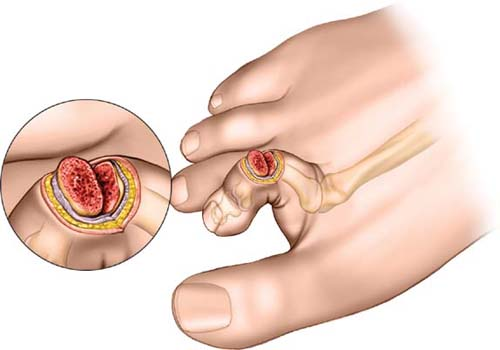 Transverse Approach for Surgery to a Hammer Toe
Transverse Approach for Surgery to a Hammer ToeThe transverse approach for surgery to hammer toe is used for surgery to correct a fixed flexion deformity of the proximal interphalangeal joint of the affected toe. In this condition, the skin overlying the dorsal aspect of the proximal interphalangeal joint is often thin and inflamed. If skin breakdown or ulceration is present, surgery should be deferred until the condition has been improved by nonoperative techniques.
The approach has no other uses. Surgery should not be carried out if there is any evidence of vascular insufficiency of the foot, since a poor blood supply to the tissue may lead to slow healing or even cause flap necrosis.
The most frequent procedure used for treatment of the underlying deformity is a proximal interphalangeal fusion of the fixed flexed joint.
The operation can be carried out under a general anesthetic, spinal anesthesia, or if confined to one toe under ring block local anesthesia.
Position of the Patient
Place the patient supine on the operating table (see Fig. 1-1). If a general anesthetic is to be used, place a tourniquet on the middle of the thigh after exsanguination of the limb. If a local ring block is to be used, place a rubber tourniquet at the base of the toe.
Landmarks and Incision
Palpate the head of the proximal phalanx that is prominent. The skin overlying it is thin, red, and often inflamed.
Excise a transverse ellipse of skin centered over the proximal interphalangeal joint of the affected toe. The incision should excise approximately 3 to 4 mm of skin and extend from one side of the dorsum of the toe to the other (Fig. 49-1).
Stay updated, free articles. Join our Telegram channel

Full access? Get Clinical Tree


